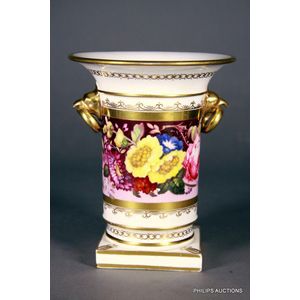Edwin Steele Decorated Rockingham Spill Vase
You must be a subscriber, and be logged in to view price and dealer details.
Subscribe Now to view actual auction price for this item
When you subscribe, you have the option of setting the currency in which to display prices to $Au, $US, $NZ or Stg.
- Gilding - Gilding is a method of ornamentation whereby a thin sheet of gold metal is applied to items made of wood, leather, ceramics, glass and silver for decorative purposes.
For furniture including mirrors, the sheet of gold is usually applied over a coating of gesso. Gesso is a mixture of plaster of Paris and gypsum mixed with water and then applied to the carved wooden frames of mirrors and picture frames as a base for applying the gold leaf. After numerous coats of gesso have been applied, allowed to dry and then sanded a coat of "bole", a usually red coloured mixture of clay and glue is brushed on and allowed to dry, after which the gold leaf is applied. Over time parts of the gilding will rub off so the base colour can be seen. In water gilding, this was generally a blue colour, while in oil gilding, the under layer was often yellow. In Victorian times, gilders frequently used red as a pigment beneath the gold leaf.
Metal was often gilded by a process known as fire gilding. Gold mixed with mercury was applied and heated, causing the mercury to evaporate, the long-term effect of which was to kill or disable the craftsman or woman from mercury poisoning. The pursuit of beauty has claimed many victims, not the least of which were the artists who made those pieces so highly sought after today. - Circa - A Latin term meaning 'about', often used in the antique trade to give an approximate date for the piece, usually considered to be five years on either side of the circa year. Thus, circa 1900 means the piece was made about 1900, probably between 1895 and 1905. The expression is sometimes abbreviated to c.1900.
- Spill Vase - Popular in Victorian times, a spill vase was a vessel for holding thin slips of wood or spills of paper with which to light a candle or pipe from a fire. For ease of access to the fire, they usually sat on the mantlepiece or had a hole in the back, so they could be hung from a wall. Their use declined with the with the evolution of heating through use of electricity and the use of safety matches in the late 19th century.
This item has been included into following indexes:
Visually similar items

A Grainger Worcester Imari-style vase, circa 1818-1820, a lovely cylindrical vase with a flared rim and a gently waisted base, decorated with orange red, cobalt and gilt floral, fruit and foliate designs interspersed with geometric patterns; pattern 575. H

A Derby spill vase, circa 1820, the cobalt vase with a flaring rim decorated to a richly gilded medallion with brightly coloured blooms upon a pedestal; red mark underside, height 11.5 cm

A Spode spill vase, circa 1810-15, a flaring vase with applied pearl borders and gilded bands, continuously decorated with flowers and butterflies on an unusual light brown ground; purple mark of Spode underside, height 11.5 cm

Early 19th century small spill vase, attributed to Flight Barr and Barr Worcester, with cobalt blue ground and hand painted seashell decoration, 9.5 cm high, Ref: Flight and Barr Worcester Porcelain 1783-1840 by Henry Sandon, The Antique Collector's Club,
